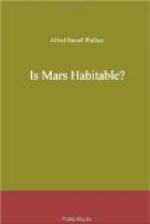No one can read this book without admiration for the extreme perseverance in long continued and successful observation, the results of which are here recorded; and I myself accept unreservedly the substantial accuracy of the whole series. It must however always be remembered that the growth of knowledge of the detailed markings has been very gradual, and that much of it has only been seen under very rare and exceptional conditions. It is therefore quite possible that, if at some future time a further considerable advance in instrumental power should be made, or a still more favourable locality be found, the new discoveries might so modify present appearances as to render a satisfactory explanation of them more easy than it is at present.
But though I wish to do the fullest justice to Mr. Lowell’s technical skill and long years of persevering work, which have brought to light the most complex and remarkable appearances that any of the heavenly bodies present to us, I am obliged absolutely to part company with him as regards the startling theory of artificial production which he thinks alone adequate to explain them. So much is this the case, that the very phenomena, which to him seem to demonstrate the intervention of intelligent beings working for the improvement of their own environment, are those which seem to me to bear the unmistakable impress of being due to natural forces, while they are wholly unintelligible as being useful works of art. I refer of course to the great system of what are termed ‘canals,’ whether single or double. Of these I shall give my own interpretation later on.
CHAPTER III.
THE CLIMATE AND PHYSIOGRAPHY OF MARS.
Mr. Lowell admits, and indeed urges strongly, that there are no permanent bodies of water on Mars; that the dark spaces and spots, thought by the early observers to be seas, are certainly not so now, though they may have been at an earlier period; that true clouds are rare, even if they exist, the appearances that have been taken for them being either dust-storms or a surface haze; that there is consequently no rain, and that large portions (about two-thirds) of the planet’s surface have all the characteristics of desert regions.
Snow-caps the only Source of Water.
This state of things is supposed to be ameliorated by the fact of the polar snows, which in the winter cover the arctic and about half the temperate regions of each hemisphere alternately. The maximum of the northern snow-caps is reached at a period of the Martian winter corresponding to the end of February with us. About the end of March the cap begins to shrink in size (in the Northern Hemisphere), and this goes on so rapidly that early in the June of Mars it is reduced to its minimum. About the same time changes of colour take place in the adjacent darker portions of the surface, which become at first bluish, and later a decided blue-green; but by far the larger portion, including almost all the equatorial regions of the planet, remain always of a reddish-ochre tint.[4]




